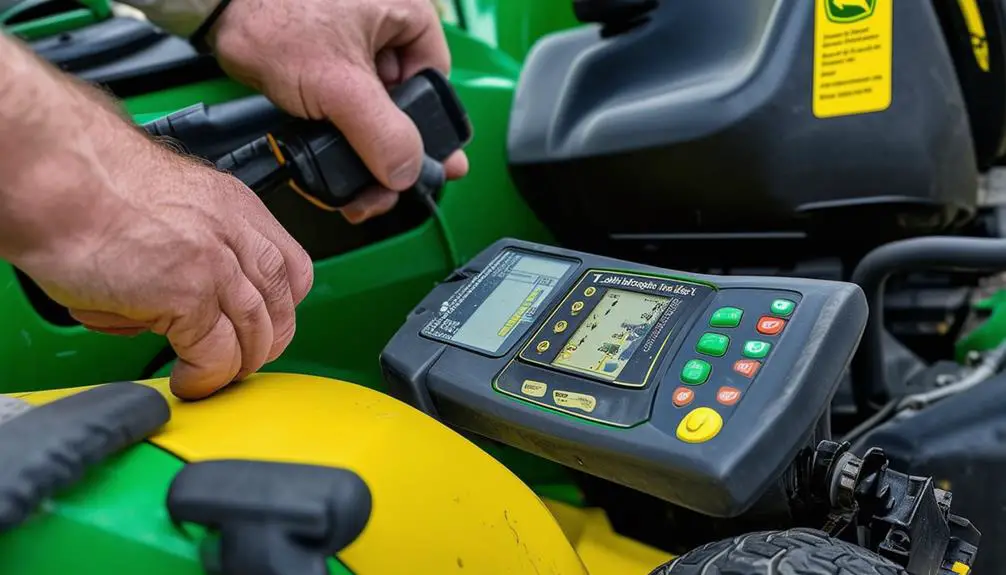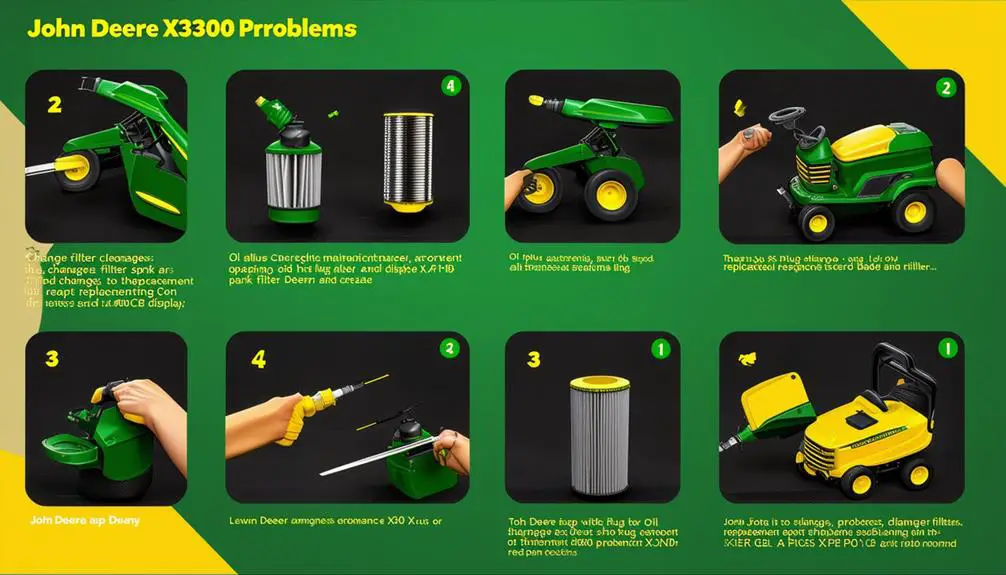Picture yourself gliding effortlessly across your lawn, the hum of your John Deere X300 a symphony of precision. But what happens when that symphony falters? Don't fret; we have three key solutions to keep your X300 running smoothly. From routine maintenance checks to fuel system TLC and a close examination of electrical components, these strategies can save you time, money, and frustration. Stay tuned to discover how these simple yet effective solutions can transform your mowing experience.
Things to Note
- Check spark plug for cleanliness and connection to address starting issues.
- Examine fuel system for clogs or filter problems hindering performance.
- Regularly change engine oil, clean air filter, and replace worn spark plugs for maintenance.
- Verify fuel quality, clean or replace fuel filter, and address blockages for optimal fuel system function.
- Monitor tire pressure and lubricate moving parts for peak performance and longevity.
Starting Problems

If your John Deere X300 is experiencing starting problems, troubleshooting the ignition system is crucial. Begin by checking the spark plug to make sure it's clean and properly connected. Sometimes a simple adjustment or cleaning can make all the difference.
Next, inspect the ignition switch and wiring for any signs of wear or damage. A loose connection or frayed wire could be the culprit behind your starting issues. Make sure to also examine the battery and charging system. A weak or dead battery can prevent your X300 from starting up smoothly.
If everything seems to check out so far, consider looking at the fuel system. Clogs or issues with the fuel filter can hinder proper starting.
Engine Troubleshooting
To diagnose engine issues on your John Deere X300, start by checking the oil level and quality before attempting any further troubleshooting steps. Low oil levels or dirty oil can cause various engine problems. If the oil is low, top it up to the recommended level. Make sure the oil is clean and free of debris, as dirty oil can lead to poor engine performance.
Next, inspect the air filter for clogs or dirt buildup. A dirty air filter can restrict airflow to the engine, affecting its performance. Replace the air filter if it appears dirty or damaged.
Check the spark plug for signs of wear or fouling. A worn-out spark plug can lead to issues with starting and running the engine smoothly. Replace the spark plug if necessary.
Lastly, examine the fuel system for any blockages or fuel quality issues. Clean or replace the fuel filter if needed, and make sure you're using fresh, clean fuel in your John Deere X300 for best engine performance.
Maintenance Tips

Regular maintenance is vital to keep your John Deere X300 running smoothly and efficiently. Here are some easy maintenance tips to help you keep your machine in top condition.
To start with, make sure to regularly check and change the engine oil according to the manufacturer's recommendations. Clean or replace the air filter as needed to ensure proper airflow. Inspect the spark plugs and replace them if they appear worn out. Additionally, keep an eye on the tire pressure to maintain peak traction and stability.
It's also essential to lubricate moving parts such as the mower deck and steering components to prevent wear and tear. To wrap up, don't forget to inspect the blades regularly and sharpen or replace them when necessary for a clean and precise cut.
Frequently Asked Questions
How Can I Improve the Overall Comfort of My John Deere X300?
To improve the overall comfort of your John Deere X300, consider adding a cushioned seat cover for extra support during long rides. Installing vibration-dampening foot pads can also reduce discomfort and fatigue.
Adjusting the seat position and steering wheel height to suit your body can enhance your overall comfort while operating the mower.
Regular maintenance and keeping the machine clean can guarantee a smooth and enjoyable experience.
What Are the Best Attachments to Enhance the X300's Functionality?
Imagine your John Deere X300 as a Swiss Army knife, ready to tackle any task.
To enhance its functionality, consider attachments like a front blade for snow removal, a bagger for efficient grass collection, or a cart for hauling heavy loads.
These additions can transform your X300 into a versatile workhorse, liberating you to conquer various yard tasks with ease.
Are There Any Tips for Extending the Battery Life of the X300?
To extend the battery life of your X300, remember to:
- Turn off the headlights when not needed and avoid using accessories when the engine is off.
- Regularly check the battery terminals for corrosion and make sure they're tightly connected.
- Keep the battery clean and fully charged during storage periods.
Can I Use Aftermarket Parts to Upgrade the X300's Performance?
You can definitely use aftermarket parts to enhance your X300's performance. These parts offer a cost-effective way to improve your machine's capabilities and customization options.
By exploring aftermarket options, you can access new levels of power and efficiency for your John Deere X300. Embrace the freedom to personalize and optimize your equipment to suit your specific needs and preferences.
Upgrade with confidence and enjoy a more tailored and enhanced performance.
What Are the Best Practices for Storing the X300 During the Off-Season?
When storing your X300 during the off-season, make sure it's in a dry, cool place away from direct sunlight. Clean the mower thoroughly, remove the battery, and add fuel stabilizer to prevent fuel system issues.
Consider covering the machine with a protective tarp to shield it from dust and debris. Performing these steps will help preserve your X300's condition and make certain it's ready to go when you need it next season.
Conclusion
To keep your John Deere X300 operating smoothly, remember to regularly check and maintain the mower, fuel system, and electrical components.
By staying on top of these three key areas, you can prevent common problems and guarantee your mower continues to perform at its peak.
So, don't forget to show your X300 some care with routine maintenance and inspections.